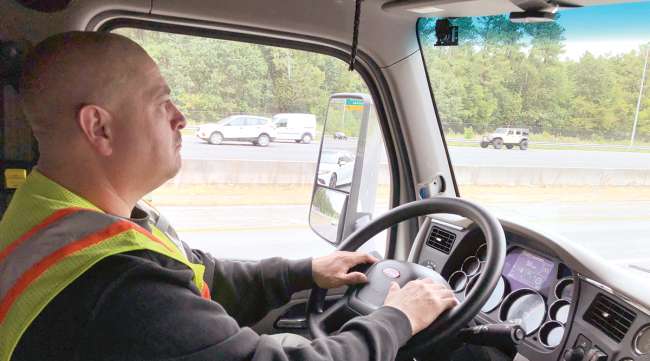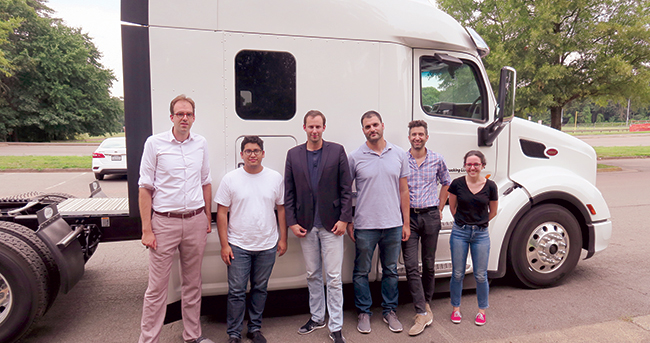Managing Editor, Features and Multimedia
Pronto Aims for 'Crash-Proof Trucks'

[Stay on top of transportation news: Get TTNews in your inbox.]
CENTREVILLE, Va. —While some self-driving truck developers are focused on building a future when heavy-duty vehicles will operate autonomously on the highway, another startup has already begun to commercialize an automated driving system that it believes is market-ready today.
Pronto.ai has started equipping some early customers’ trucks with its self-driving technology, which not only requires a driver, but actively insists that the driver stay engaged and will even steer the truck to a safe stop on the side of the road if he or she is unresponsive.
The company showcased those capabilities in a Class 8 tractor during a ride-along demonstration for Transport Topics here Aug. 5.
Pronto has been traveling across the country this year providing similar demonstrations to motor carriers and industry stakeholders to build more awareness and a better understanding of its technology.
“We’re trying to show them what’s real,” said Ognen Stojanovski, co-founder and chief operating officer. “There’s been a lot of promises, a lot of hype. … So we’re trying to show them the technologies that we can take today to build an actual product that can tangibly improve safety right now.”
Rather than attempting to remove the driver from the equation, which the company believes is still many years away, Pronto is focusing on enhancing safety with an additional layer of driver-assist technology that complements safety features already built into modern trucks.
The goal, company executives said, is to develop a “crash-proof” truck.
Pronto’s technology represents SAE Level 2 automated driving, in which the system can automatically brake, accelerate and steer, but still requires the driver to remain attentive at all times.
The company’s Copilot system functions like an advanced form of adaptive cruise control with lane centering. While the system is engaged on the highway, the truck operates itself while the driver monitors traffic with his or her hands resting on the steering wheel and feet off the pedals.
The driver is still responsible for manually executing lane changes and navigating highway entrance and exit ramps.
“We want to make sure that people don’t just understand what the system is and what it does, but also what it does not do,” Stojanovski said. “It is not a robot truck.”
To ensure that the driver remains attentive while Copilot is active, Pronto uses a driver-facing camera mounted in the cab to track the driver’s head and eye movements.
If the driver doesn’t do a standard mirror check within a four-second span, the system issues an audible alert, the first step in a series of escalating warnings patterned after safety systems in the aviation industry.
If the driver doesn’t react to the initial alert, the system issues a more severe audible warning and a stern voice urges the driver to “drive now.”
But things get particularly interesting when the driver doesn’t respond at all.
WANT MORE NEWS? Listen to today's Daily Briefing
In that case, Pronto’s system enters its Safe Landing protocol. The truck automatically activates its turn signal, decelerates, pulls over to the shoulder, comes to a stop and turns on its hazard lights. Throughout the process, the voice repeats its audible warnings: “drive now, pulling over.”
While such situations should be very rare, Pronto executives hailed this safety net for the driver as a groundbreaking feature.
For the first time, this system provides a way to prevent an accident if the driver becomes incapacitated, perhaps due to a health emergency, or just falls asleep at the wheel, they said.
During the ride-along demonstration, Pronto’s truck drove on northbound and southbound Route 28 in Fairfax County, Va., for about 15 miles.
The driver activated Copilot with a simple switch, at which point the system took over acceleration, steering and braking.
The automated driving system automatically adjusted to tighter lanes while passing a construction zone and also operated in a traffic jam during the early stages of rush-hour traffic in the Washington, D.C., area.
The driver activated the Safe Landing procedure by manually blocking the onboard camera system, but apart from that demonstration, the Copilot system drove completely automated from exit to exit.
Without the need to constantly focus on keeping the truck centered in its lane, the driver is free to pay closer attention to what’s happening on the road around them.

Stojanovski (far left), Levandowski (third from left), Miller (fourth from left) and other members of Pronto's team. (Seth Clevenger/Transport Topics)
As Pronto begins to roll out its technology to early customers, the company also has had to contend with disruption in its leadership ranks.
Pronto co-founder and CEO Anthony Levandowski, who guided the ride-along with Transport Topics, stepped down from that role a few weeks later after he was indicted by a federal grand jury on charges that he stole trade secrets from his former employer, Google.
In a statement, Levandowski’s lawyer denied the charges and said the indictment “rehashes claims discredited in a civil case settled more than a year and a half ago.”
Shortly after leaving Google’s autonomous vehicle business, now known as Waymo, Levandowski founded self-driving truck startup Otto. That company was acquired in 2016 by Uber, which has since ended its self-driving truck program.
Pronto, meanwhile, has elevated its chief safety officer, Robbie Miller, to CEO.
During the demonstration event in Virginia, Miller said Pronto’s technology not only improves safety, but significantly reduces driver fatigue.
Just the act of steering for up to 11 hours a day “can be quite exhausting,” he said.
Although drivers must continue to watch the road while the Copilot system is engaged, they can sit in a more comfortable position and rest their hands on the wheel.
“You’re going to be more awake and alert while you’re driving, and even at the end of the day, you’re going to feel a lot better,” Miller said.
Pronto’s onboard technology uses cameras and radar to track the vehicle’s surroundings. It does not use lidar sensors or rely on any mapping of the route as a prerequisite.
The system is designed to easily fit within existing business models in the trucking industry rather than requiring fleets to adjust their operations to utilize the technology.
“Our idea is to integrate smoothly into the way trucking companies operate today,” Stojanovski said.
Currently, Pronto installs the technology in existing trucks as an aftermarket system, but the company is interested in partnering with truck manufacturers as well.
Pronto requires that the truck be equipped with an automated or automatic transmission, but beyond that, “most any truck will do,” Stojanovski said.
The company does prefer to work with 2014 and newer model years because it’s less likely that they will encounter mechanical issues unrelated to the automated driving technology.
The introductory pricing for Copilot is $5,000.
Stojanovski said the technology is in the early commercialization stage. He did not reveal the identity of Pronto’s early customers, but said the company has begun installing a limited number of its systems on trucks operated by both large and small fleets.
“They’re putting them in their everyday business operations,” he said.


